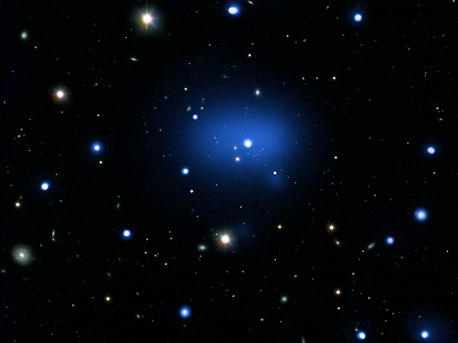Galaxy Clusters in the Young Cosmos
Record Breaking Galaxy Clusters
 © DSS; ESO/VLT
|
This is a composite image of the most distant galaxy cluster yet detected.
“This object is near the distance limit that we expect for galaxy clusters,” explains Stefano Andreon of the Institute for Astrophysics in Milan, who took part in the discovery of the galaxy cluster. “We don’t think that gravity works fast enough to produce much older galaxy clusters.” Galaxy clusters are the largest gravity-bound objects in the cosmos. By observing such a structure in the young universe, astronomers hope to obtain information about the formation of structures at that time.
The first clues about the far-off galaxy cluster had already been provided in 2006 through infrared observations with the United Kingdom Infrared Telescope. Among other things, measurements in optical and infrared ranges made with the Canada-France-Hawaii-Telescope and the Spitzer Space Telescope confirmed the great distance to the galaxies in this cluster. But only evidence of hot gas between the galaxies found by the Chandra X-ray Satalite provided conclusive proof that this collection is a true gravity-bound galaxy cluster.
The astronomers now wish to observe further and examine whether the cluster has fully materialized, what the chemical composition of the galaxies looked like at this early stage of cosmic development, and whether the temperature of the gases between the galaxies is linked to the mass of the cluster as it is with closer objects. And of course the researchers hope to find more galaxies, perhaps even farther away.
Source: NASA, Translation: Beth Field
Galaxy Clusters in the Young Cosmos
Record Breaking Galaxy Clusters
 © DSS; ESO/VLT
|
This is a composite image of the most distant galaxy cluster yet detected.
“This object is near the distance limit that we expect for galaxy clusters,” explains Stefano Andreon of the Institute for Astrophysics in Milan, who took part in the discovery of the galaxy cluster. “We don’t think that gravity works fast enough to produce much older galaxy clusters.” Galaxy clusters are the largest gravity-bound objects in the cosmos. By observing such a structure in the young universe, astronomers hope to obtain information about the formation of structures at that time.
The first clues about the far-off galaxy cluster had already been provided in 2006 through infrared observations with the United Kingdom Infrared Telescope. Among other things, measurements in optical and infrared ranges made with the Canada-France-Hawaii-Telescope and the Spitzer Space Telescope confirmed the great distance to the galaxies in this cluster. But only evidence of hot gas between the galaxies found by the Chandra X-ray Satalite provided conclusive proof that this collection is a true gravity-bound galaxy cluster.
The astronomers now wish to observe further and examine whether the cluster has fully materialized, what the chemical composition of the galaxies looked like at this early stage of cosmic development, and whether the temperature of the gases between the galaxies is linked to the mass of the cluster as it is with closer objects. And of course the researchers hope to find more galaxies, perhaps even farther away.
Source: NASA, Translation: Beth Field






